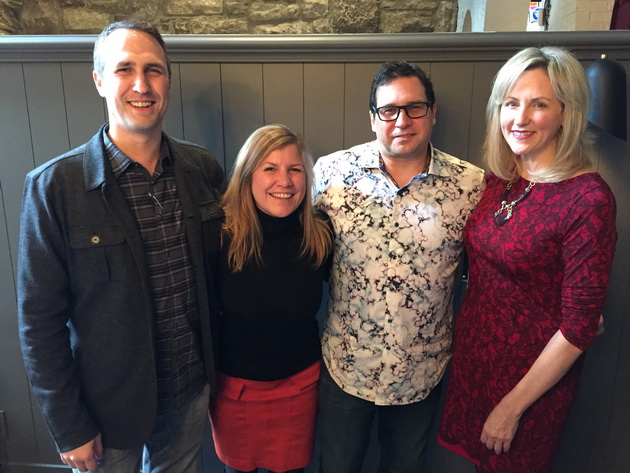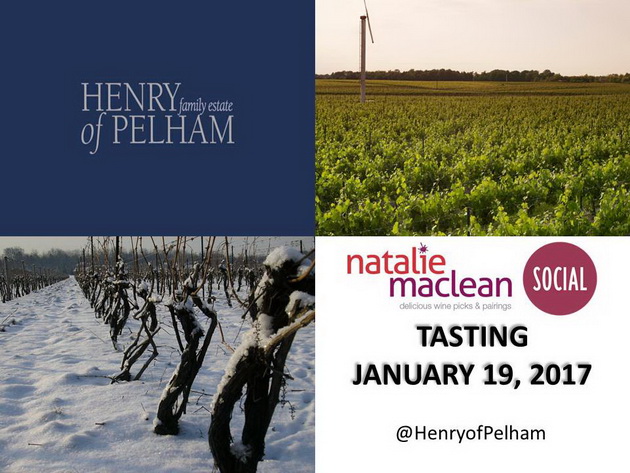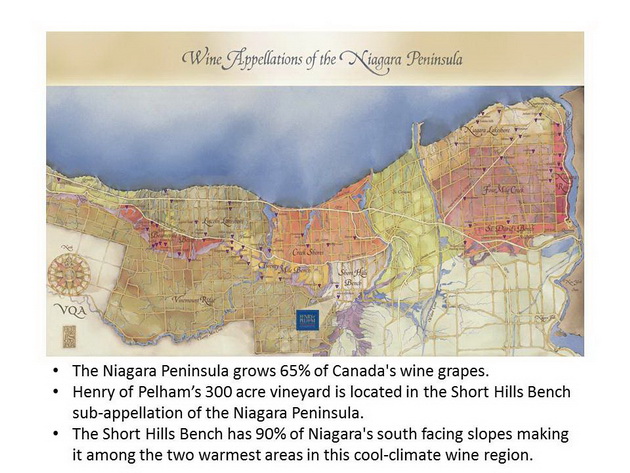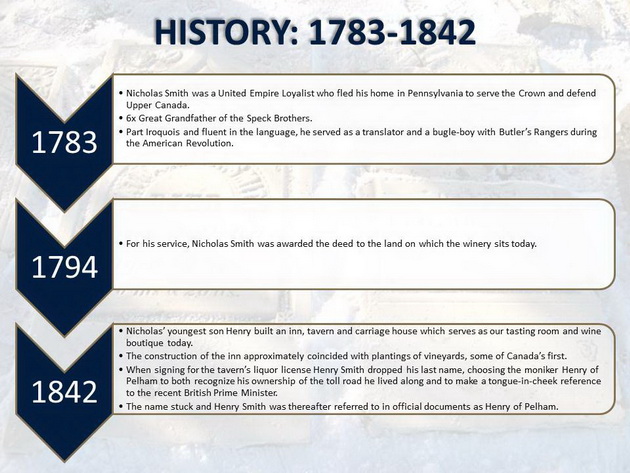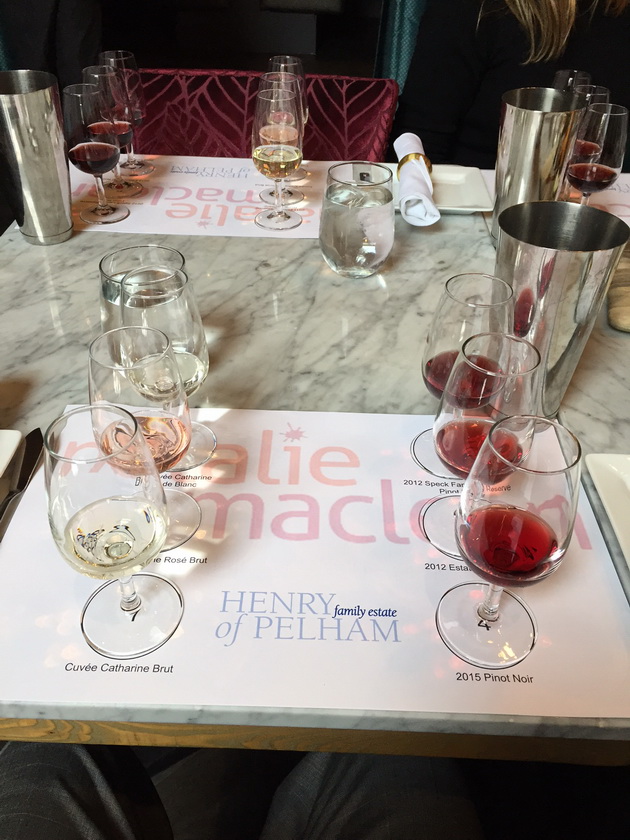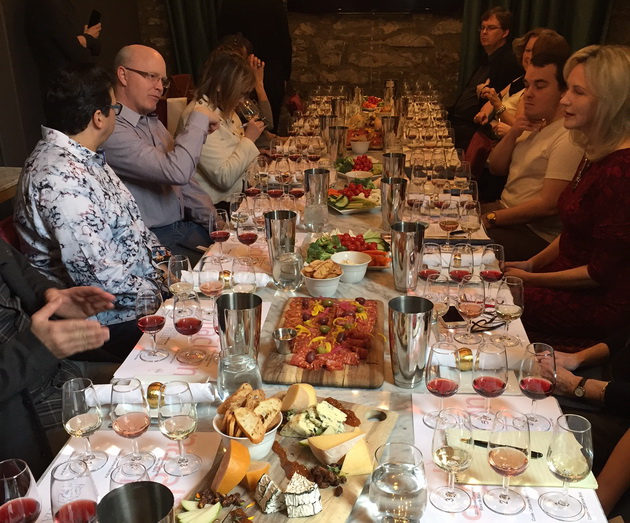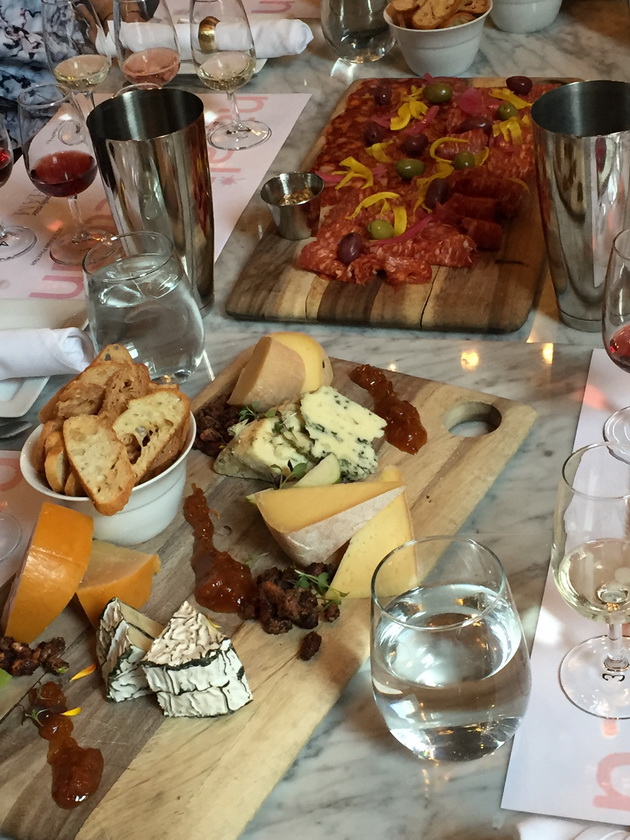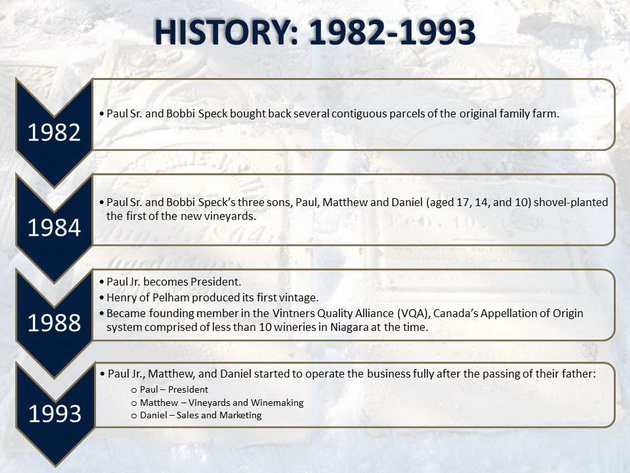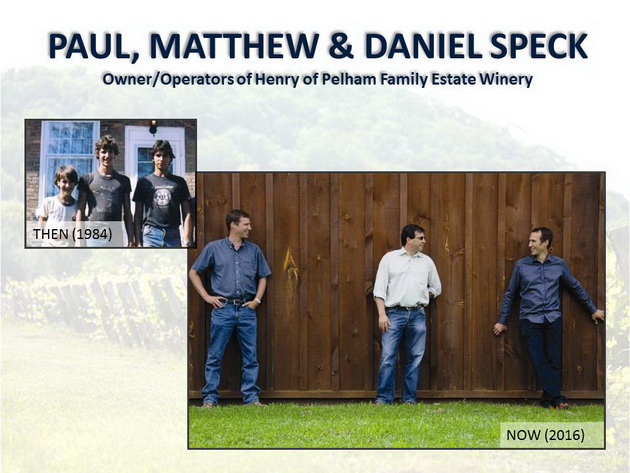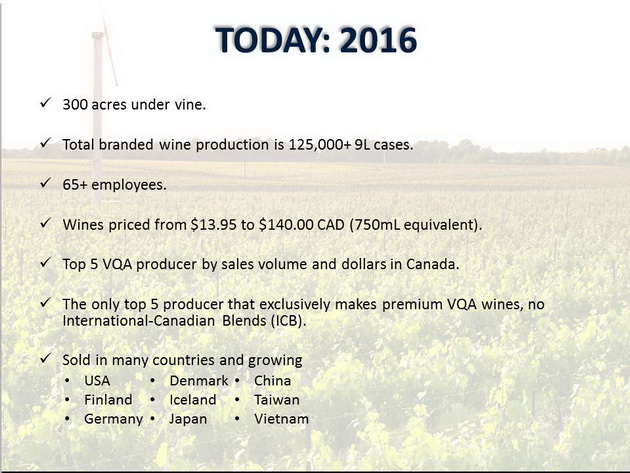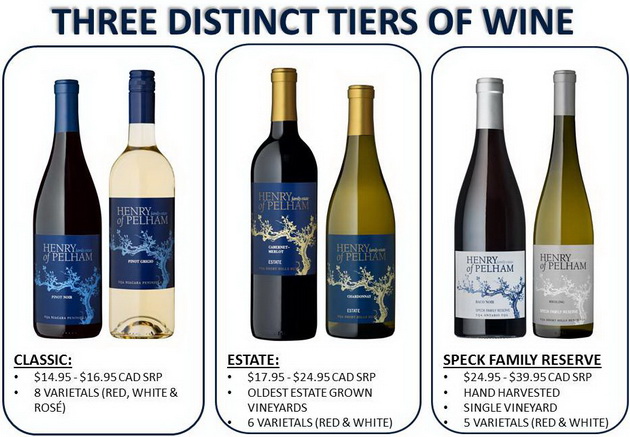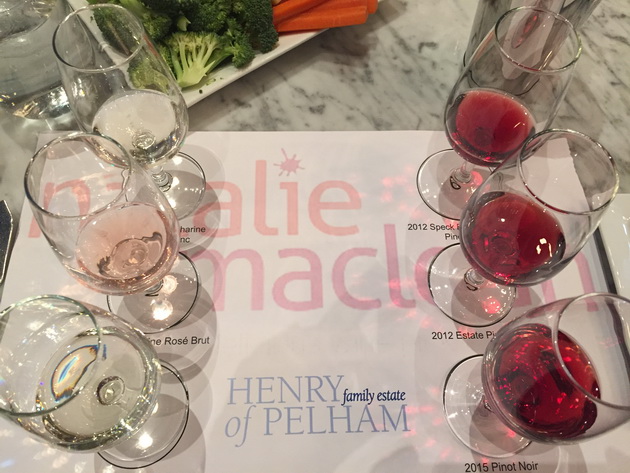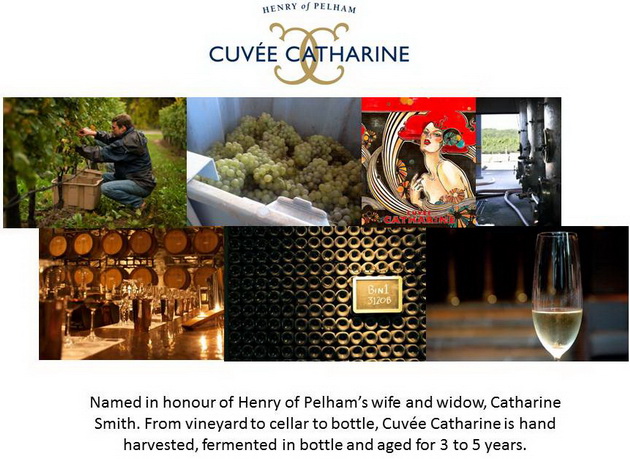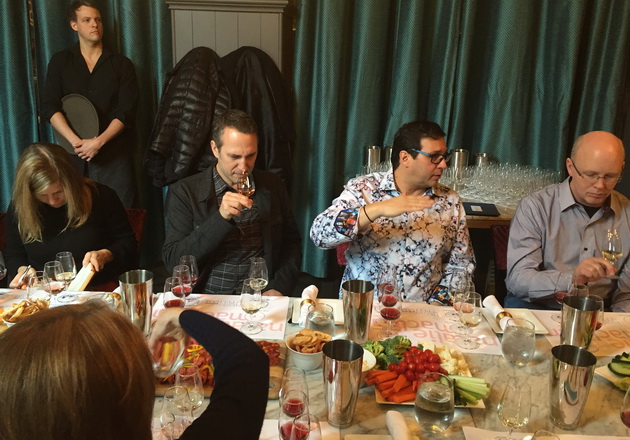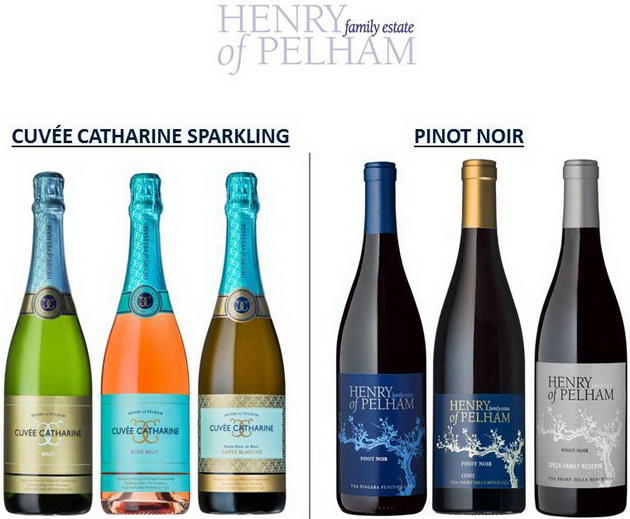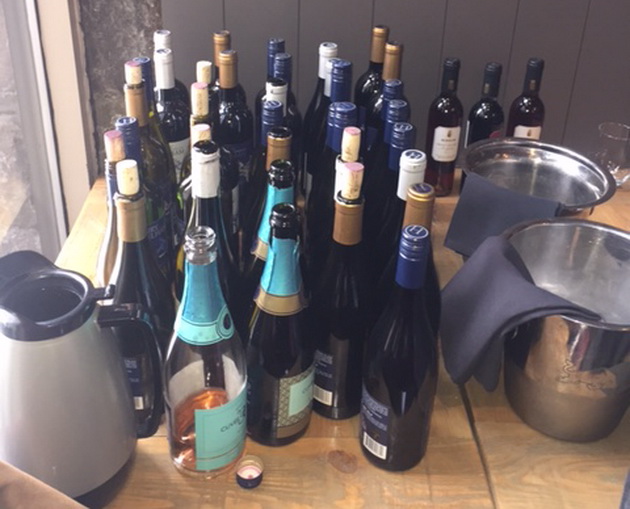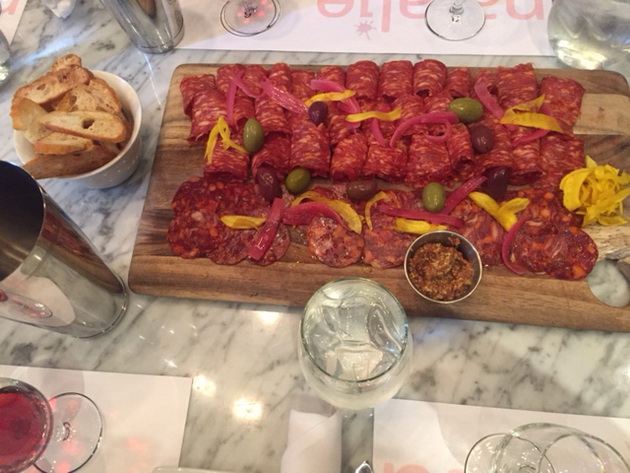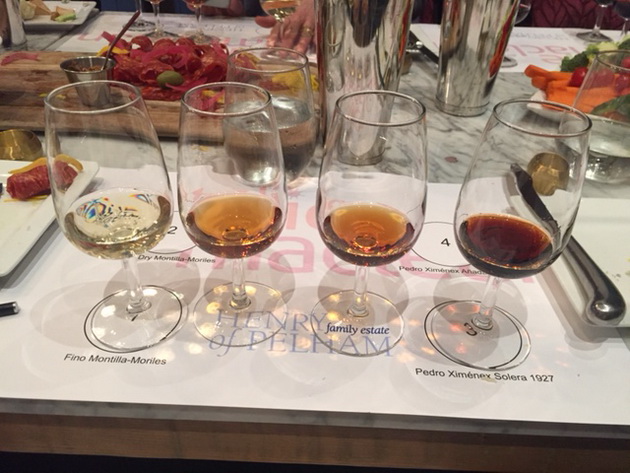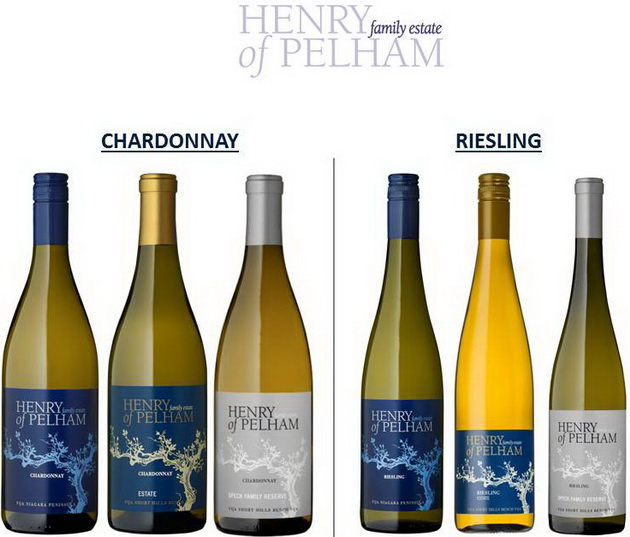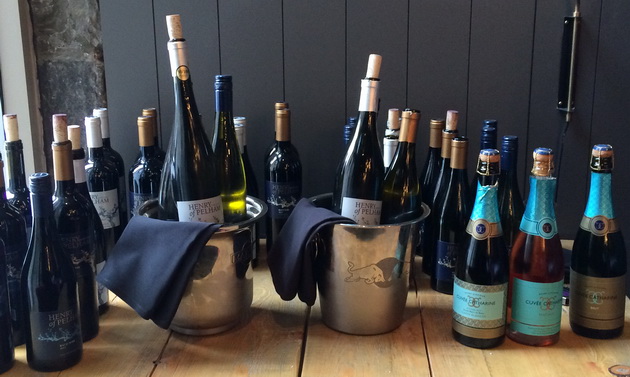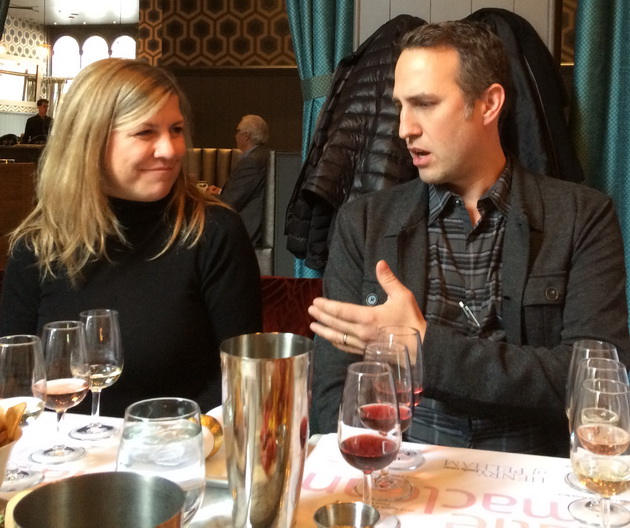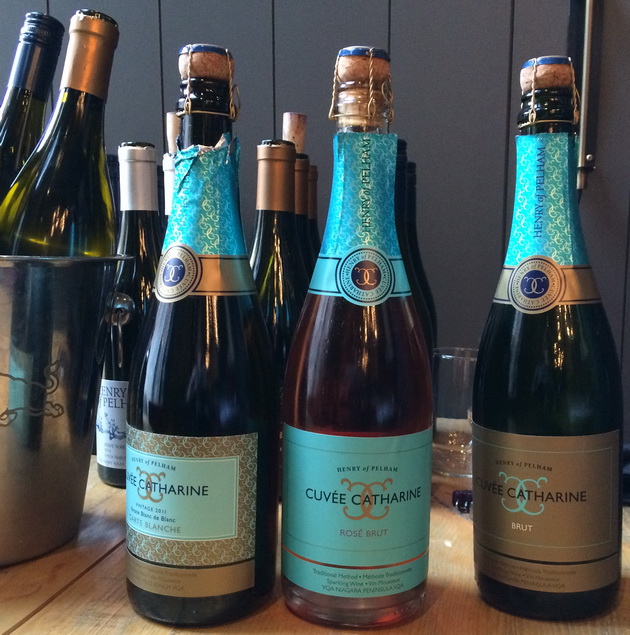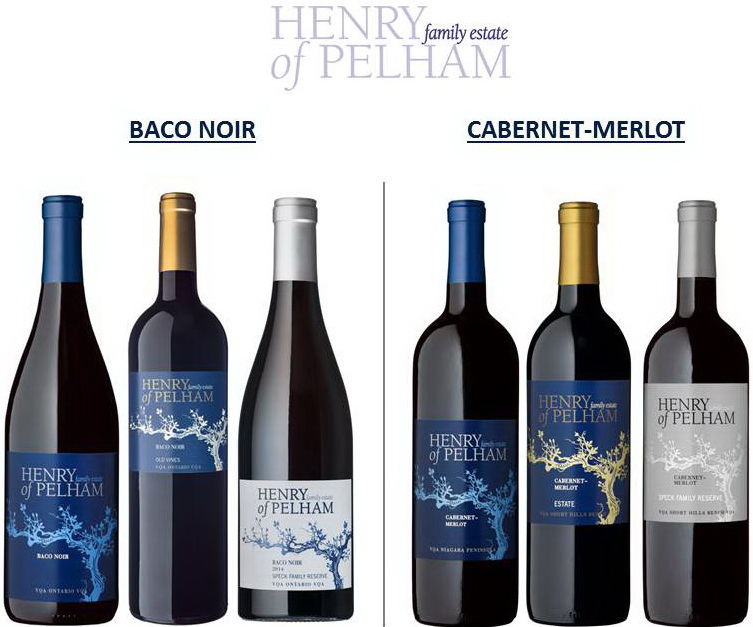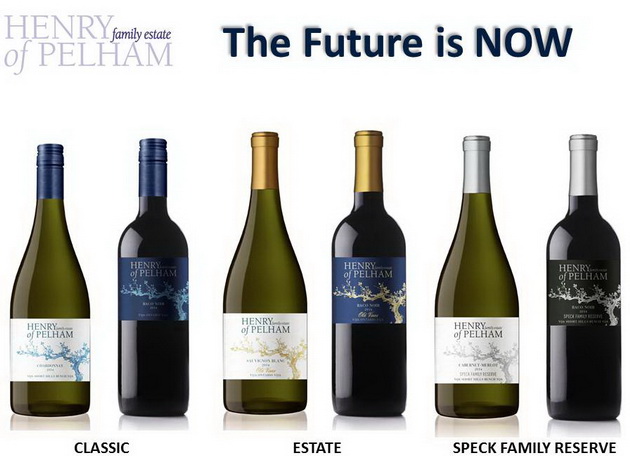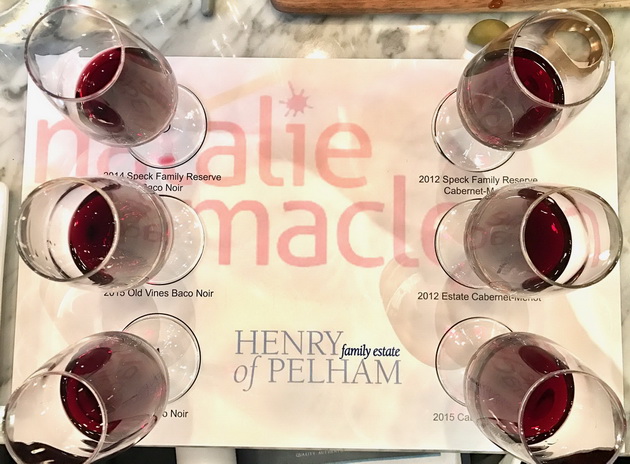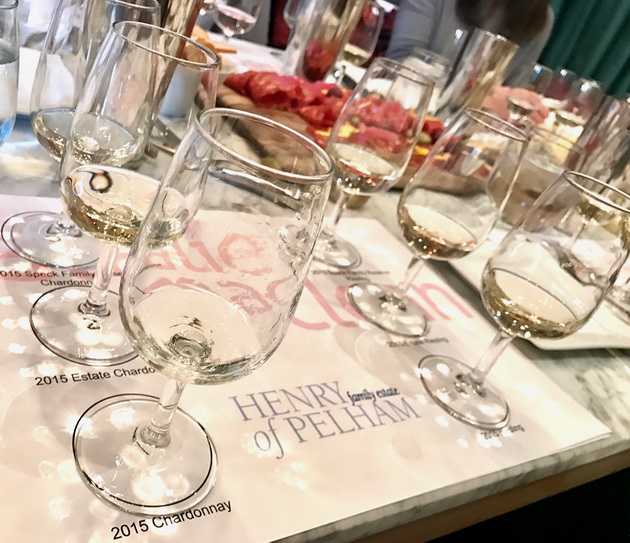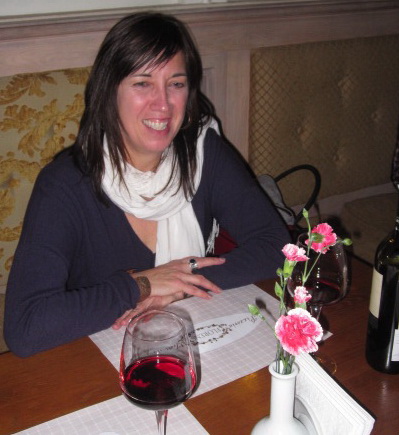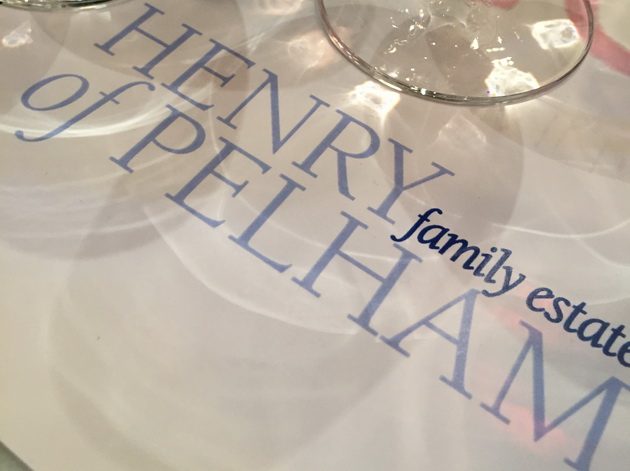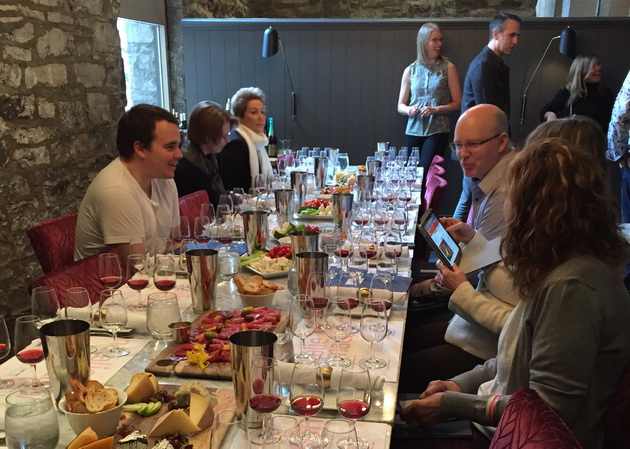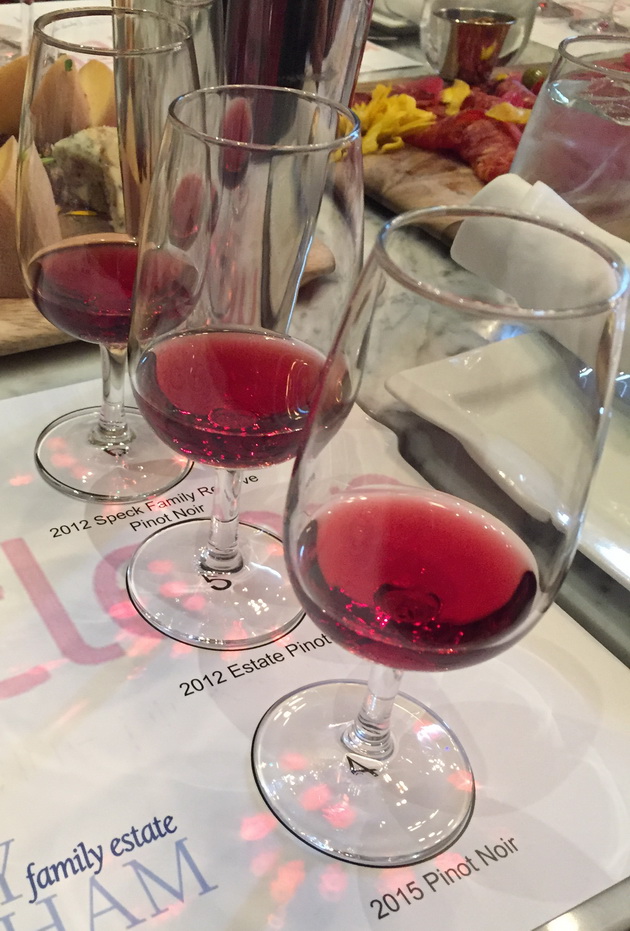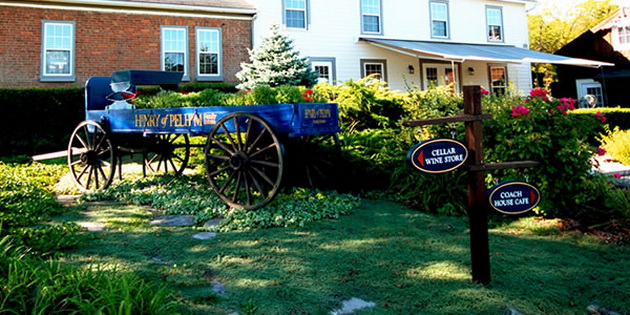Jennifer MacDonald Havers
Wine Columnist, Ottawa Citizen
What a lovely opportunity to sit down with the Speck Brothers (well, two of three – Paul and Daniel) from Henry of Pelham winery to learn more about their family’s winemaking as well to taste across their portfolio of wines.
Their Henry of Pelham portfolio is generally set up along three tiers; Classic, Estate, and the Speck Family Reserve.
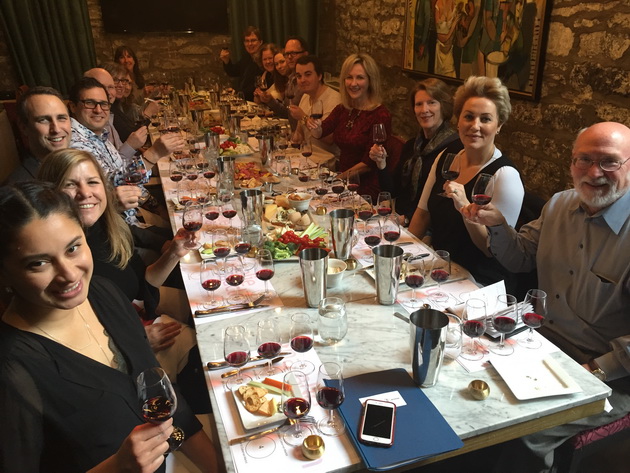
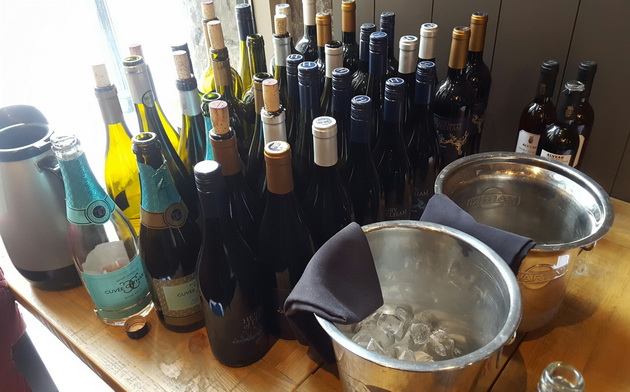 Photo by Jennifer MacDonald Havers
Photo by Jennifer MacDonald Havers
By adhering to rigorous quality standards and keeping production at modest levels for the higher tier (Speck Brothers Reserve), the resulting high quality wines trickle down to the Estate and Classic labels as well.
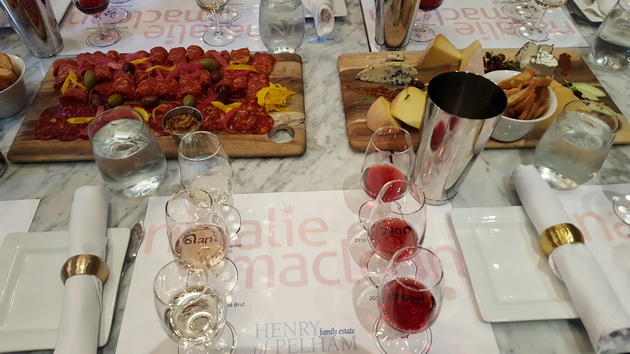 Photo by Jennifer MacDonald Havers
Photo by Jennifer MacDonald Havers
This became evident while tasting the portfolio, as their “Classic” tier wines all showed impressive quality and were not out of place being showcased next to their Speck Family Reserve. Something to remember when you’re in the market for a $15 wine!
Their sparking wines have always been a favourite of mine. Named for Henry’s widow, Catherine, who took over and managed the family inn, tavern (still on the property today), and toll road after her husband’s passing, these wines beautifully pay homage to the matriarch of the family.
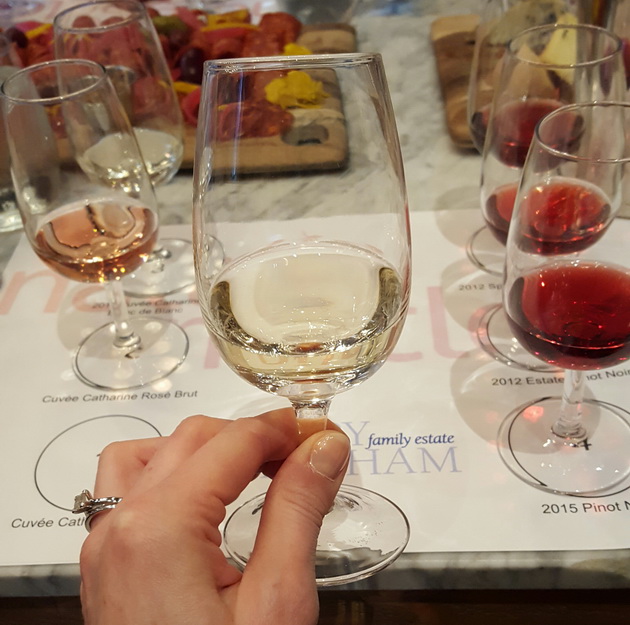 Photo by Jennifer MacDonald Havers
Photo by Jennifer MacDonald Havers
While we cannot call sparkling wines in Ontario “Champagne”, it was interesting to hear how Henry of Pelham follow and even exceeds some of the quality or aging standards for Champagne, such as: for time the wine is left on lees (sometimes up to 60 months!) I was also surprised to learn that the “dosage’ used in the Blanc de Blanc was estate Chardonnay that’s been blended and could contain wine up to 20 years old!
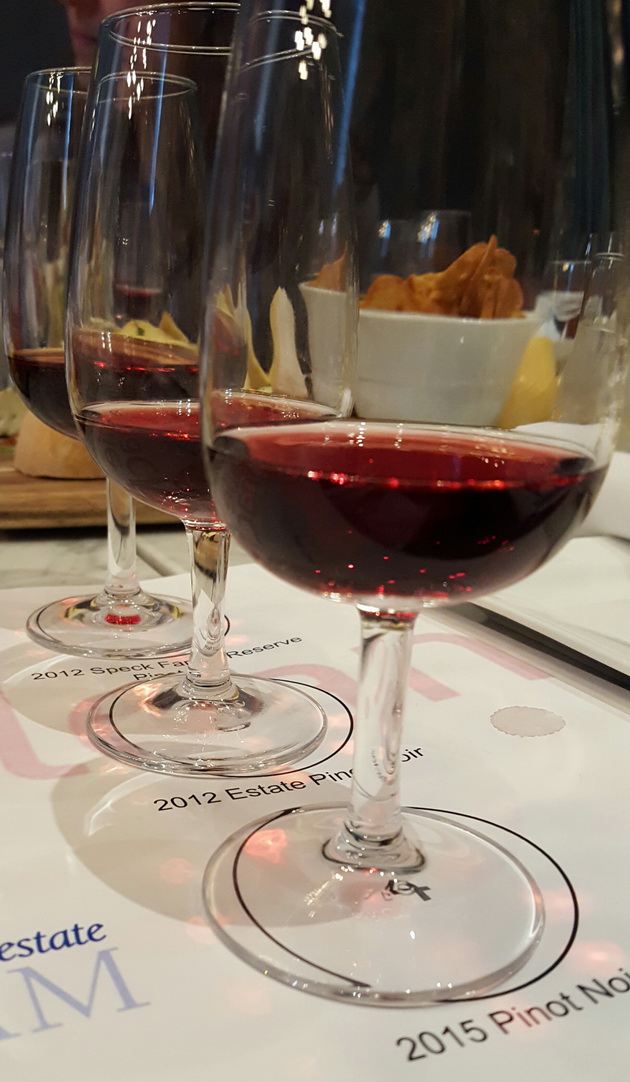 Photo by Jennifer MacDonald Havers
Photo by Jennifer MacDonald Havers
I’ve seen and tried their wines over the years, but it’s always nice to hear specifically about the attention to detail that different winemakers apply to their craft. They are a producer I would often recommend to people curious to try Ontario Sparkling wine and Baco Noir, but this was a great opportunity to try other wines they offer, and I was impressed across the board.
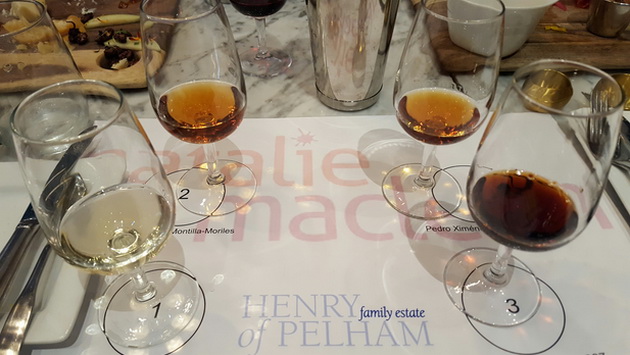 Photo by Jennifer MacDonald Havers
Photo by Jennifer MacDonald Havers
Henry of Pelham Winery Cuvee Catharine Brut Sparkling
Niagara Escarpment, Ontario, VQA, Canada
Henry of Pelham Winery Cuvee Catharine Rosé Brut
Niagara Escarpment, Ontario VQA, Canada
David Skinner
Wine & Travel Columnist, Outdoor Magazine
A Speck of Advice from Henry of Pelham Wines
Ever since the Speck brothers helped their father replant their vineyards with vinifera grapes in 1984, they have continued to provide leadership and passion for the quality of wines that can be produced in Ontario’s Niagara region.
Their enthusiasm is obvious when you hear Daniel, and his brother Paul, speak about the viticultural value of the Short Hills Bench sub-appellation.
The adage that wine gets its character from the soil, its personality from the vintage, and its quality from the influence of man, is foundational to how this family manages the Henry of Pelham Estate business.
Some of Ottawa’s sommeliers gathered at the Social restaurant to taste Henry of Pelham’s key offerings and learn a bit more about the way these wines are carefully crafted and nurtured. The history of Henry Smith and how he became known as Henry of Pelham for the toll he charged to use his road (obviously Pelham road as we know it today) was fascinating.
From those early roots to when the Speck family bought the land from their cousins in the early 1980’s the tradition of family commitment to the land persists. This is clearly evident in their presentation and their wines.
The tasting presented both the sparkling wines, named after matriarch Catherine, and still wines, carrying her husband Henry’s name.
The Cuvee Catherine line included the Brut, Rosé Brut and the Blanc de Banc style aptly named “Carte Blanche”. The former blends were pinot noir and chardonnay with increasing pinot content for the rosé, but the latter bottling provided a platform for chardonnay to shine.
Only the best hand-picked grapes were used for Carte Blanche and the front and tail runs from the pressings are discarded leaving only the best juice for fermentation. This process allows the winemaker to deal with the challenges of using fruit that has not yet fully ripened.
The early juice run of pressed early harvest grapes is dominated by the skins, infusing too much green flavor and the late part of the pressing is stem influenced. Add the 60 months on lees in bottle before disgorgement and the results of the traditionally made sparkling wine are exceptional.
Moving to the still wine selections, Daniel pointed out that they use a “declassification” approach to the different types of wine they produce. This approach means that they have three tiers for each brand. Usually this is designated as Speck Family Reserve, Estate and Classic.
In simple terms, they start with their best grapes and choose to hand pick them and make the wines for the reserve and estate wines while they use machine picking for the classic tier. The wines that are deemed to be the best of the varietal are given the family stamp of quality through the reserve label and those that just miss that mark become estate wines. This is how they manage to provide offerings for all palates and budgets and is a very sensible approach to satisfying the heterogeneous marketplace.
Their primary vines are focused on Pinot Noir, Chardonnay, Riesling and Baco Noir. All are made in the style of northern European wines and the Speck brothers point out that putting Canada into a “new world” tasting doesn’t make as much sense as putting them up against the German, Alsatian and Loire offerings. That’s something to keep in mind, along with their preference for the order of tasting.
The old adage of putting whites before reds, ignores the fact that some whites are quite aggressive, both in intensity and acidity, that they can mute the delicacy of many Pinot Noirs. Let’s start tasting from less intense and less acid/tannin along the path to bolder styles, and treat the old white before red advice, as secondary to this more palate-friendly approach. These “Specks” of advice are invaluable.
Henry of Pelham Winery Cuvée Catharine Carte Blanche Blancs De Blanc 2011
Short Hills Bench, Niagara Peninsula, Ontario V.Q.A., Canada
Henry of Pelham Winery Chardonnay 2015
Niagara Escarpment, Ontario VQA, Canada
Doug McMillan
Accredited Sommelier & Blogger
I have to say up front, that Henry of Pelham is probably my favourite Ontario wine producer. I’ve had such a great experience with their whole range of wines over the years that I’m something of a fan, so this was a real treat for me. The tasting was at Social, which is a very nice place for a tasting. Nice room, good food (charcuterie in this case), and a good atmosphere.
We started with the Cuvee Catharine sparkling wines, which I’d never tried before. These are fantastic sparkling wines in three styles. These are traditional method sparkling wines that stand up well against French Champagnes. The name is a nice nod to the French history of Widows running the Champagne houses as well as Catharine is the name of the original ‘Henry of Pelham’s’ wife, who outlived him and carried on the winery.
The tasting progressed through a range of their Riesling, Chardonnay, Pinot Noir, Baco Noir, and Cabernet Merlot blends. Each wine is now made in three “levels” using declassification of grapes.
The more expensive wines use better grapes, lower yields, etc, but the value across the range is certainly there. There was lively discussion of barrel types, production methods, Ontario vintages and many other things that you can really only get when talking with the winemakers.
I learned that American oak (which some of their wines use) is much better than it used to be, and is closer to French oak now, in character.
As normally happens with wine tastings of this sort, I come away with several “must-have” additions to my small cellar. This time, for me, it was the sparkling wines, which are spectacular, as well as the Chardonnays. I’m normally not a big fan of Chardonnay, but these were quite impressive; just the right balance of fruit and oak and a great flavour profile.
The Baco Noir, my “go-to” wine when heading to a dinner at a friend’s house, was as great as always. I frequently tell people that Henry of Pelham does Baco Noir better than anyone else in the world.
Check it out if you haven’t already, but definitely don’t limit yourself to only their Baco Noir.
Henry of Pelham Winery Chardonnay 2015
Short Hills Bench, Niagara Peninsula, Ontario V.Q.A., Canada
Henry of Pelham Winery Pinot Noir 2012
Niagara Escarpment, Ontario, V.Q.A., Canada
Greg Hughes
Wine Writer & Sommelier
Henry Smith, of Pelham, settled on his land in Ontario just after the American revolutionary war. He had fought with Butler’s Rangers, but now left the Service to establish a farm and would eventually start a family with his wife, Catherine.
Eventually, they would have fourteen children and a thriving farm planted with native grape species.
Henry answered to the name Henry of Pelham as a sort of tongue-in-cheek joke – a plutocratic title for the magnate of Pelham road, where his land was situated.
In 1984, the three Pelham sons, related to the original founding Smiths, began replanting much of the hybrid vines with European cultivars. 1988 was their first commercial vintage and they have established themselves as one of the most well-respected wineries in Ontario. Their portfolio contains a tiered line of reds, whites, and icewines, as well as the lauded Cuvee Catharine series of traditional method sparkling wines, which have burgeoned under their success to become, ostensibly, a separate brand.
Cuvee Catharine makes reference to Catharine Smith, the family matriarch and widow. In the style of the merry widows of Champagne, the modern proprietors thought it fitting to name the series in honour of Catharine.
While visiting the Henry of Pelham estate, in the Niagara Peninsula, Catharine’s resting place can be found on-site.
The Cuvee Catharine sparkling wine series has three selections; all made in the traditional Champenoise method. The Brut and the Rosé Brut are both dry, non-vintage wines built using Pinot Noir and Chardonnay.
The Brut has proportionately more Chardonnay. A portion of the base wine is barrel fermented and left for three years before being disgorged.
The Rosé does not see any barrel aging, nor does it see quite as long aging on its yeast lees (two years). This Pinot dominant blend keeps it fresh and vibrant, whereas the Brut is more opulent and broad on the palate.
The centrepiece is the Cuvee Catharine Carte Blanche. It resembles a more premium style of wine built in a similar style to the Brut. It is 100% Short Hills Bench Chardonnay from a single vintage that sees a phenomenal 60 months on its lees! It teems with crystalline structure, and yet is rich and full bodied.
Grapes used for sparkling have to be treated differently than those utilized for still wine. They’re generally picked earlier to retain acidity.
The juice taken from the crushed grapes go through certain stages of quality.
The first part of the juice that is pressed is somewhat acidic from the skin. The tails are close to the seed, which is bitter. The pressings in between the head and tail are what is sought out for the premium Carte Blanche sparkling.
They utilize a lot of French and American oak in their wines.
American oak has a stigma of not being as subtle as French oak. American oak, in their opinion has changed over the years. They air dry it longer, so it has a lot more subtlety. It is no longer sappy and ostentatious.
They used to have to source from barrel makers that made stuff for whiskey, initially. It was all that was really around in the 1980s, when they started.
Still, there are certain things that should generally only see French oak – generally, anything with a Burgundian varietal (Chardonnay or Pinot Noir) in it.
Short Hills Bench is near Beamsville Bench – on the clay and limestone, but it is a warmer pocket. Short Hills Bench has an extremely high portion of Niagara’s Southern-facing aspect.
They also have some fairly old vines, for such a young winemaking territory. Most of these are planted in their proprietary star vineyard: the Speck Vineyard.
The Speck Riesling has some 33 year old vines. They’re mostly Weisse 21B. It was the Riesling clone initially brought to Niagara. Vineland, Henry of Pelham, and Cave Spring all still have some of the original vines that they planted with when their vineyards were in their infancy. They have since experimented with some other Riesling clones – one Alsatian, but mostly they stick to German clippings.
For the Speck Chardonnay, they actually can’t identify the clones planted. The Chardonnay plots were a mix of clones. Apparently, there are sometimes chimera mutations that produce interesting fruit.
Henry of Pelham Winery Riesling 2015
Niagara Escarpment, Ontario VQA, Canada
Henry of Pelham Winery Speck Family Reserve Riesling 2013
Short Hills Bench, Niagara Peninsula, Ontario V.Q.A., Canada
Gwen Barton
Certified Sommelier
What a great way to spend an afternoon – Henry of Pelham wine tasting with Dan and Paul Speck!
The tiered approach to the tasting allowed us the opportunity to enjoy the Classic offering of their varietals, the Estate, and through to the high end Speck Family Reserve. Chardonnay, Pinot Noir, Riesling and Baco Noir and Cabernet Sauvignon – an impressive array.
The Brothers shared some of the history of the winery, including their decisions not to give up on certain grapes – such as Baco Noir – despite some criticism at the time in the industry – and we are sure glad they didn’t. All expressions of this wine we tasted were lovely – however the Reserve was wonderful. And thanks to Social for allowing us to pair it with the ash based Cheese- a remarkable combination.
Another treat was the tiered tasting of the Cuvée Catherine sparkling series – Blanc de Blanc, Brut and Rosé.. this allowed is to note the subtle differences among these festive wines. And LOVE the labels- the powder blue draws out the pink hues in the Rose – so pretty.
Henry of Pelham Winery Cabernet Merlot 2015
Niagara Escarpment, Ontario VQA, Canada
Henry of Pelham Winery Speck Family Reserve Cabernet Merlot 2012
Niagara Escarpment, Ontario VQA, Canada
Jane Staples
Wine Columnist, Ottawa Wedding Magazine
A dreary January day got a whole lot more fun on Jan. 19th when I attended a tasting of Henry of Pelham wines at Ottawa’s Social Restaurant.
Proudly Canadian, and having a lot of fun putting Niagara wines on the map, these brothers have a lot to be proud of. They shovel-planted many of the vines themselves in the 1980’s and 90’s on their family estate and take a deep personal satisfaction in watching its success.
We tasted no less than 18 of their wonderful wine products and that was not even all of them! Even when the media presentation suffered a technical glitch and they had to wing it, they gave a very informative and engaging presentation.
They led us through a highly organized tasting, starting with sparkling wines, then through reds, whites and more reds. That’s right, they like to start with the Pinot Noirs, go to Chardonnay, then work their way to the reds again.
They have a 3-tier selection, offering literally wines for every budget from a wide group of varietals. That means wine for everyday consumption, wines for dinner parties and lots of options for wine gifts.
I was already acquainted with their Baco Noir and the delicious Cab Sauv Icewine. This tasting provided me with the opportunity to get to know many of their other great wine products.
Highlights/favourites for me were the rich, satiny 2015 Speck Family Reserve Chardonnay and the luscious 2012 Speck Family Reserve Cab-Merlot. Either would make a great gift.
Next time somebody asks you what Ontario wines are like, tell them about Henry of Pelham Winery. Better yet, do a blind tasting and pour them a glass of Riesling or Baco Noir from H of P. They will be delighted and you will be proud, too, of our great Ontario wines.
Photo by Emily Alonzo
Henry of Pelham Winery Old Vines Baco Noir 2015
Niagara, Ontario VQA, Canada
Henry of Pelham Winery Speck Family Reserve Baco Noir 2014
Niagara, Ontario V.Q.A., Canada
Jon Steeves
Accredited Sommelier & Blogger
Picture the landscape 150 years ago, where the Henry of Pelham we now know, first began the journey. With 14 kids and land, Mr Henry Smith was the owner of a toll road, named Pelham Road.
In the fields grew some native grape varietals. The storied Winery, Henry of Pelham, melds the landscape near Pelham Road and the farmer, named Henry Smith, a meeting of man, landscape, fruit and terroir, which has become a significant presence in the Canadian wine business.
Meeting the storied Speck brothers in Ottawa was a pleasure.
Meeting 18 of their favourite wines, equally so. Henry of Pelham is making some fantastic icewines, some great traditional method sparkling wines, and has a diverse array of unique expressions of single varietal, small parcel wines. Storied and legendary on some fronts, this family winery has a lot going for it and equally so for wine lovers.
I appreciated the passionate presence, dedication to quality and the family nature of the Henry of Pelham business. Family business is hard business.
Brothers and owners Paul and Daniel Speck spent some time walking through 18 of their wines, where I met several for the first time. I was impressed with the spectrum of wines they are vinifying and the experimentation – commitment to learning and the VQA brand.
Being a man with a passion for bubbly, I enjoyed the The Cuvee Catharine Brut, The Cuvee Catharine Rosé Brut and the 2011 Estate Blanc de Blanc rated 90/100, and the Carte Blanche, which stood out as exceptional, rated 92/100.
The 2012 Pinot Noir Estate and Pinot Noir Speck Family Reserve both rated 90-91/100. The 2015 Estate Chardonnay and Speck family Reserve rated 90-91/100. The 2015 Estate Riesling and 2013 Riesling Speck family Reserve rated 90-92/100. The 2012 Cabernet – Merlot Speck Family Reserve rated 91/100 and 2014 Baco Noir Speck Family Reserve rated 90/100.
These wines stood out, passed the 89 mark… into the low 90s. Great showing of the best vintages of each of the varietals. This showing provides a picture into what the vineyard and winery can do and what they seek out. Their standard setting examples, in my opinion were solid and spot on.
Tasting the Henry of Pelham bubbles, still Riesling, and Riesling Icewines leaves me with a huge appreciation for Henry of Pelham. Perhaps a road trip to St. Catharines, Ontario is in order as Canadian’s celebrate Canada’s 150 in 2017….
Henry of Pelham Winery Speck Family Reserve Chardonnay 2015
Niagara Escarpment, Ontario VQA, Canada
Henry of Pelham Winery Pinot Noir 2015
Niagara Peninsula, Ontario VQA, Canada
Kimberly Inksater
Accredited Sommelier & Blogger
I’ve been a fan of Henry of Pelham Baco Noir (Old Vines or Speck Family Reserve) for years but admittedly I hadn’t tasted their full portfolio of wines. Although I grew up not far from Niagara, I didn’t know the history of the winery until two of the three Speck brothers shared their family story.
Henry Smith owned the Henry Smith Tavern (or Mountainview Inn) at the crossroads of three townships, including the township of Pelham; thus the origin of the winery’s name. Henry Smith was one of the sons of the original landowners, Nicholas and Catharine Smith.
Paul Speck, who purchased land from cousins to start the winery in 1982, is a descendant of another son of Nicholas and Cartharine. To add to the confusing repetition of names in the family tree, Henry also married a woman named Catharine and she is recognized in the winery’s series of sparkling wines “Cuvée Catharine.”
Today the three sons of Paul Speck operate Henry of Pelham and have expanded to a total of 300 acres in the sunny Short Hills Bench sub-appellation (not all the land is under vine).
Each style of wine includes three classifications, from classic (great value wine) to Estate and Speck Family Reserve. The classic wines use Niagara grapes. The Estate and Speck Family Reserve wines are made from grapes from the oldest vines from the family vineyards, with the harvest being used for the Reserve wines.
I was pleasantly surpised by the sparkling wines of the Cuvée Catharine offerings. The 2011 Cuvée Catharine Blanc de Blanc or “Carte Blanche” is made from hand-picked Chardonnay grapes and only the best juice from the centre of the grape is used.
The result is phenomenal. The aromas of nuts, vanilla, and brioche reflect the traditional method, partial barrel aging and lengthy bottle aging of 60 months. I detected citrus and baked apple on the palate and there is a long lemony finish that makes this wine stand out.
But let me end with how I was introduced to Henry of Pelham wines. Baco Noir is a hybrid grape produced by Francois Baco who crossed Folle Blanche and an indigenous North American grape called Vitis Riparia. It was first cultivated in the 1950s and was used for blends.
Henry of Pelham took this wine to a new level by planting with a new trellis system in the 1980s and ensuring significant air flow and low yields. These viticulture practices are necessary due to the fact Baco Noir grapes have thin skins and ripen early.
To complement the grape’s features the winery uses extended maceration and oak aging to maximize the colour and flavours. The Speck Family Reserve Baco Noir is my traditional pairing with turkey during the holidays.
Henry of Pelham Winery Speck Family Reserve Pinot Noir 2012
Short Hills Bench, Niagara Peninsula, Ontario V.Q.A., Canada
Henry of Pelham Winery Riesling 2015
Short Hills Bench, Niagara Peninsula, Ontario V.Q.A., Canada
Pam Chiles
Wine & Food Writer
I am a big fan of Henry of Pelham, but tend to migrate to their Baco Noir mostly, with the occasional dip into their sparkling wines and Riesling, so it was quite fun to discover many of the rest of their offerings at this tasting.
We were off to a great start with the sparkling line, comprising three “Cuvee Catharine” styles (all highly regarded award winners), followed by samples of the 3 tiers (Classic, Estate and Speck Brothers Reserve) in each of the Pinot Noir, Chardonnay, Riesling, Baco and Cabernet-Merlot varieties.
Tasting through these flights was an excellent study in how the winemakers select, process and vinify the grapes and age the wine. In general, the higher the tier, the more rigorous the grape selection (think picking and sorting), the lower the yields, the older the vines, the longer the ageing (and the more expensive, the oak barrels!). I should note the winery also produces Pinot Gris, Sauvignon Blanc, a rosé, and of course, ice wine (fabulous).
The Speck brothers, Dan and Paul (minus Matt on this day), are a dynamic duo – we were treated to lots of interesting stories, facts and family history. The land on which the vines grow, was granted to one of their ancestors in the late 1700’s and vinifera (Riesling and Chardonnay) were planted by the brothers and their parents in 1988.
Some of these vines, which pre-date clonal selection, are still around and contribute to the Estate and Speck Family Reserve tiers of the wines – worthwhile checking out as the resulting complexity is very alluring. This was particularly evident in the Riesling and Cabernet-Merlot.
The Speck brothers make the best Baco Noir in Ontario (there’s a declaration!). They seem to have found and coaxed out the finer points of the grape and craft quite an elegant wine from a rather unloved hybrid.
Their Old Vines Baco comes from vines planted in the 1980’s and 1990’s, with lower yields resulting in fruity, full-bodied wines. The Classic level Baco is fabulous, especially at its low price-point ($15), and the Reserve (top-of-the-line) is another beast altogether, intense, powerful and complex, maybe Ontario’s answer to a Cali Zin?
Fun Fact: Baco Noir has low tannins, is thin-skinned and the flesh is coloured.
New and Noteworthy: Five acres of Merlot were planted last summer. (Merlot fans rejoice!)
Revealing Revelation: 2016 is possibly the best vintage since 2012 – so look out for those wines!
Many thanks to Dan and Paul for taking the time to show us their wonderful wines and answer our questions – a very enlightening lunch, indeed!
Henry of Pelham Winery Cabernet Merlot 2012
Short Hills Bench, Niagara Peninsula, Ontario V.Q.A., Canada
Henry of Pelham Winery Baco Noir 2015
Niagara Escarpment, Ontario VQA, Canada
Rachelle O’Connor
Wine Writer & Sommelier Judge
Once again, we had the pleasure of attending a luncheon showcasing many of the fine wines from the well known Niagara-on-the-Lake producer “Henry of Pelham”.
The hosts for our luncheon were brothers Paul and Daniel Speck. This winery is a true success story of a family business for many different reasons, spanning decades of dedication, shared success, and ambitious goals.
Paul Speck, President, is also a founding director of VQA, quite an accomplishment. He still plays an active role today in many National organizations promoting Canadian wine, specifically Niagara-on-the-Lake, on a global front.
Mathew Speck, who was not in attendance, has many awards under his belt and fulfills the role of Viticultural Manager and Vice-President of the company.
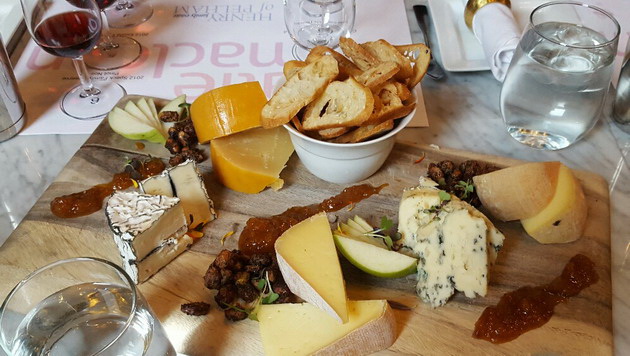 Photo Credit: Rachelle O’Connor
Photo Credit: Rachelle O’Connor
Last but not least, Daniel Speck, Vice-President of Sales and Marketing is a hands-on owner and plays a large role in the final stages of the wine composition, working alongside his two other brothers and the wine makers.
It was evident from the start of the luncheon that both Paul and Daniel have a true passion, not only for the present day goals of their established winery, but they also maintain an unwavering commitment to deliver a quality product.
I think most evident was the sparkle in their eyes when they spoke of their special ancestry and lineage of the winery. The stories they shared about the vineyards, the name of the wines, time with their parents in the early days, cultivating the land by shovel and the bottle labels, really gives you an inside appreciation for their success. It is well deserved.
The wines we tasted represented the winery very well. The Speck Family Reserve wines really present a superb representation of so many carefully planned details, all coming together simultaneously, to deliver a great product – consistently, year over year.
Thank you for sharing your knowledge, experience and wonderful wines. It was very much appreciated!

Getting to know Henry of Pelham was an entertaining treat. Speck brothers Paul & Dan (missing Matt – someone had to hold down the fort) – the proprietors of Henry of Pelham – delivered a thorough and fun tasting.
I am pretty nutty about history. History holds my attention more than chocolate! Perhaps more than cheese even, seeing that we were served a gorgeous cheese platter that no one dared touch until the Speck brothers paused for a breather. You see, Henry of Pelham doesn’t just have a cool story, they have a legacy!
They have been around the Canadian wine scene since ‘day one’. Paul, Matt and Dan’s great-great-great grandfather, Nicholas Smith, a loyalist who moved to Upper Canada sometime around 1778 (since it was the American Revolution and all) settled on some land in the Niagara Escarpment that was bestowed unto him and his family for his service as a United Empire Loyalist.
By 1842, Nicholas’ youngest son – the earnest, comical and busy Henry Smith – built an inn, a tavern, a carriage house and started planting the first vines on Pelham land. Upon applying for his liquor license, he applied under the pseudonym “Henry of Pelham” to showcase his ownership of the Pelham toll road and, allegedly, to lend a kinship with the then British Prime Minister named Sir Henry Pelman. Funny guy, eh?
Coincidentally, we still have a toll road running through the Niagara Escarpment. Any votes out there for the “Henry of 407”?
Well, the name stuck!
Fast forward to 1982 to find Paul Sr. and Bobbi Speck, descendants of Henry Smith and beloved parents of the Speck Bros, invested in the land that is their family heirloom. The Speck brothers shared memories of replacing old vineyards and replacing them with vinifera (modern wine producing) grapes. They stopped at the Baco Noir vines, though. Something inspired them to keep those vines. Good call!
Today, Henry of Pelham is showcasing some fantastic wines. They bottle under three levels of quality – the “Classic” at the entry level, the “Estate” at the mid-level, and the “Speck Family Reserve” at the top end.
They have a massive portfolio wines from whites to reds, from dry to sweet from stills to sparklings. In my opinion, their Rieslings and the Sparkling Wines showcase incomparable quality for value.
One burning question I am still awaiting a response from each of the brothers is simply, “how do you guys do it?” Seriously, “how do you three get his pony to race?” Stay tuned!
 Photo Credit: Rachelle O’Connor
Photo Credit: Rachelle O’Connor
